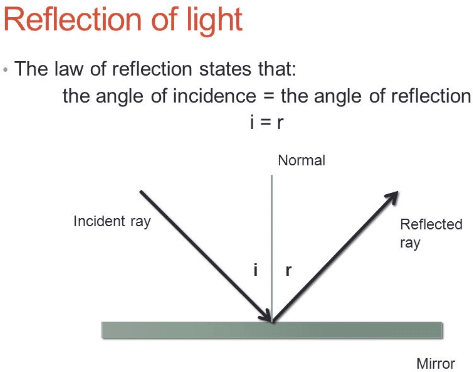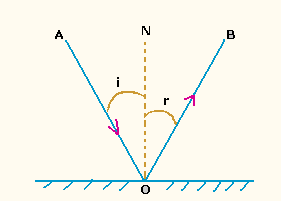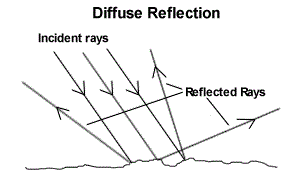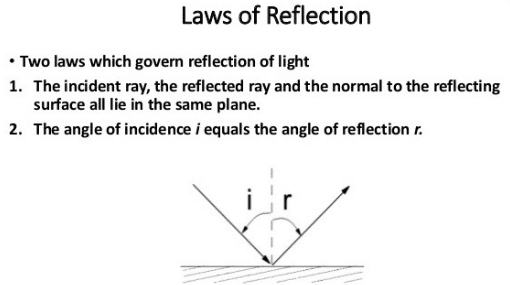Reflection of Light Examples in daily life
 What is reflection of light?
What is reflection of light?
When light from one medium falls on the surface of another medium, it bounces back in the same medium such that the angle of incidence is equal to the angle of reflection. There are two types of reflection of light, regular reflection and irregular reflection. Light reflected from mirror is an example of a reflection of light.
Reflection of light Examples in daily life
- Reflection of light enables us to see.
- We see the colors of different objects due to reflection.
- We see nonluminous objects due to the reflection of light.
- The number of things you see in a day is due to the reflection of light.
Reflection of light definition
Reflection of light is defined as: “When light traveling in a certain medium falls on the surface of another medium, a part of it turns back in the same medium.” We see a page of a book because light reflects from each part of the page in all directions so that some of the light rays from each part of the page enter our eyes. Because almost no light is reflected by the printed words, we “see” them as black areas.
In the early 1700 s, were two ideas about the nature of light; particle nature and wave nature. Newton put forward the idea of the corpuscular nature of light. According to him, light consists of tiny, fast-moving particles. Maxwell formulated the wave theory of light. In 1802, Thomas young proved the wave nature of light experimentally. In 1900, Planck suggested that light consists of small packets of energy called photons were confirmed by experiments. Now we know that light has dual nature; wave as well as particle nature.
How reflection Occurs?
Reflection occurs when a light ray strikes a shiny surface(mirror) and bounces off. The ray that strikes the shiny surface is called an incident ray. The ray that bounces off is called a reflected ray. The point at which incident ray strikes is called the point of incidence. The line perpendicular to the point of incidence is called normal. The incident ray forms an angle of incidence with the normal. It is denoted by ‘i’. The angle that reflected ray forms with the normal is called the angle of reflection. It is denoted by ‘r’.
Types of reflection
There are two types of reflection that are given below:
Regular reflection
The nature of reflection depends on the smoothness of the surface. For example, a smooth surface of silver reflects the ray of light in one direction only. The reflection by these smooth surfaces is called regular reflection.
Irregular reflection

Most of the objects in the everyday world are not smooth on the microscopic level. The rough surfaces of these objects reflect the rays of light in many directions. Such reflection is called irregular reflection.
Laws of reflection of light

- The angle of incidence is equal to the angle of reflection.
- The incident ray, normal ray, reflected ray at the point of an incident all lie on the same plane.
Applications of regular and irregular reflection
Regular and irregular reflections of light have many applications in our everyday life.
- Due to the regular reflection of light, we look at our image in the plane mirror.
- We can turn the sunlight towards dark places by the regular reflection of light with the help of a shiny surface.
- Sunlight does not reach directly into our rooms, but we can see things in our rooms. This is because of the irregular or diffused reflection of light. The light scatters in different directions when it shines on dust particles.
- We can see things just before sunrise and just after sunset due to the diffused reflection of light.
Reflection of light in mirrors
A shiny surface is called a mirror. A plane mirror has a smooth and flat surface. We see images in a plane mirror when light reflected by the mirror enters our eyes. We use a plane mirror to see our faces. We observe that:
- The image formed by a plane mirror is upright (straight upward).
- The image is equal in size to the object.
- The image is laterally inverted. It means your right becomes left in the image.
- The image in the plane mirror is virtual. It means the image disappears
Watch video about reflection of light:
People may ask :
- What is the Refraction of light?
- What is the Diffraction of light?
- What is the Interference of light?
- What is the Polarization of light?
Related searches on Physics:

Your are waste